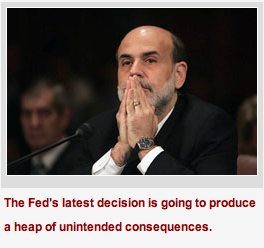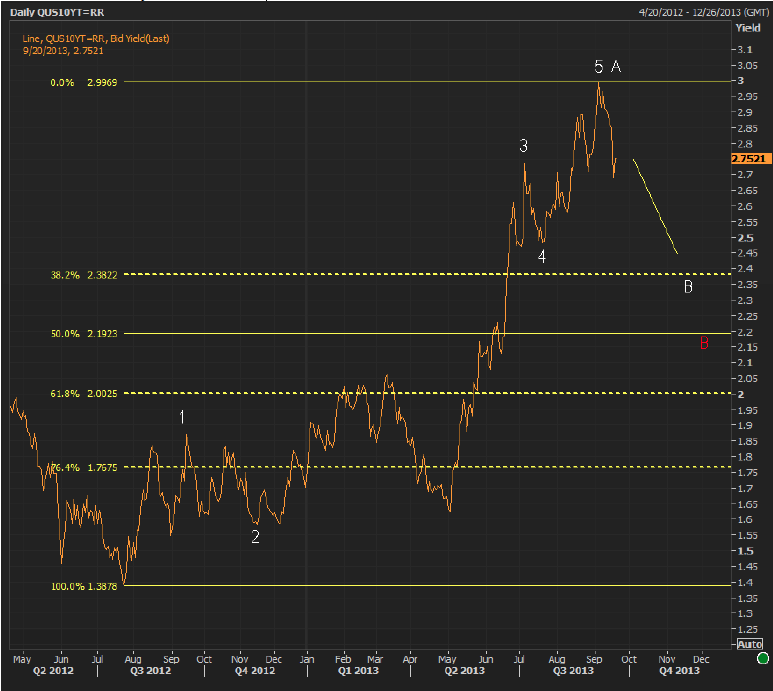Bonds & Interest Rates
Dear Mr. Bernanke,
Never mind all those foolish critics out there who said otherwise. They can criticize you all they want, but had they been in your shoes back then, they would have implemented the very same measures and policies you did. I’m sure of it.I hope this letter works its way into your inbox. After all, I used to be one of your staunchest supporters. You’ve been unfairly treated in the past. When the global financial system melted down in 2008-09, you took the right measures.
You had no choice but to pump trillions of dollars into the global economy. If you hadn’t, the world would have gone back to the dark ages.
But with your latest decision, I think you blew it big time. Here’s why:
First, you believe the U.S. economy is not yet strong enough to stand on its own two feet. But do you really think the money-printing-addicted U.S. economy is going to get better with still more opiates?
Is that the right medicine at this time? After all, if the U.S. economy is going to turn the corner, it’s going to do it with or without you.
And if it’s not going to turn the corner at this point, then all your hard work and all the money that you continue to print isn’t going to amount to a hill of beans.
 Second, you’re worried that Washington may soon run out of money. The debt-ceiling battle is about to ramp up again with a vengeance. There’s even a real chance the government will run out of funds and have to shut down.
Second, you’re worried that Washington may soon run out of money. The debt-ceiling battle is about to ramp up again with a vengeance. There’s even a real chance the government will run out of funds and have to shut down.
I say if Washington can’t get its act together, then let it shut down. Let it run out of money.
It’s high time those pranksters in Congress took their jobs and responsibilities seriously.
It’s high time they cut their wasteful spending, slash their own salaries and pensions, lay off their own staff, turn off the air conditioning and dim the lights.
The rest of us are trying our hardest to run our businesses and our homes within our means. Isn’t it about time that our leaders in Washington do the same?
Third, you’re worried that bond traders got way ahead of themselves by anticipating higher interest rates. After all, since April, the yield on the U.S. 10-year Treasury has shot up from 1.6 percent to 2.8 percent. You think that’s too much, too soon.
But if it is too much too soon, so what? The free markets always correct themselves. If rates went up too far too soon, the market would correct it and rates would come back down on their own.
And if rates continued higher instead, then it would likely be because the U.S. economy is picking up, and growing. In that case, the economy would catch up with higher interest rates. Isn’t that a good thing?
So why not let the bond market do its own thing, adjust to reality, of its own accord?
Fourth, you’re also clearly worried that Europe can’t stand on its own two feet either. On that score, I agree with you. I know there’s a lot of talk out there that Europe has finally turned the corner.
I say baloney. Most of Europe is sliding deeper into a depression. European banks are still in tatters. Greece needs a new bailout. Portugal will need another one soon. Italy remains fragile, to put it lightly. And Spain is a mess.
But is Europe really our problem? Why do we have to try and fix Europe’s ill-conceived attempt at a single currency and monetary union, which is the root cause of its crisis?
A few years ago, yes, Europe needed help. But at this point, it’s up to Europe’s leaders to make the right moves. They need to implement a national deposit insurance program. They need to form a true central bank, not a figurehead central bank with the national central banks of each country still calling their own shots.
They need a single sovereign bond market. Not a fractured bond market made up of what amounts to municipal bonds of each country acting like a pseudo-sovereign euro bond.
By giving Europe’s leaders more time, all you’ve done is coddle them and given them the opportunity to continue to drag their feet on the much needed reforms they need to make. That is not going to help the situation.
Fifth, you’re worried that rising interest rates are negatively impacting emerging markets. Mr. Bernanke, I live in Asia. Interest rates are rising here because there are signs of inflation appearing everywhere. The minimum wage is going up all over Asia. Factories are humming along on overtime. Chinese growth is propelling all of Asia forward. Economic growth is about to explode to the upside again.
Rising rates are not negatively impacting Asia. Quite the contrary, they are a sign of growing economies. Of growing demand for money and credit. Isn’t that the way it should be? Isn’t that how healthy economies are supposed to work?
Now, I know a new Fed Chairperson will be appointed shortly. But that shouldn’t impact your thinking one iota.
You still have a couple of months to get the patient — the U.S. economy — out of bed and walking on its own two feet. It’s OK if it’s a little unsteady at first.
Do the right thing. Start weaning the economy off the drugs. Let the rest of the Federal Open Market Committee know that’s the right thing to do. I think — no, I know — you’ll be pleasantly surprised at the result.
Just look at the price of gold. It’s not flashing any panic signals. If deflation were as big a problem as you think it is, then gold would already be well below $1,000 an ounce. But it’s not.
And if inflation is expected to be a big problem, then gold would be much, much higher than it is.
Instead, gold is experiencing a bit of disinflation, a cooling off, which is a good thing. It’s still caught in a downtrend that probably won’t come to an end until it falls a bit more, below $1,150 … down to about $1,045.
And the decline that’s occurred in gold, its multi-hundred dollar plunge from its high at $1,921 in September 2011, has occurred despite all the money-printing you’ve done.
That’s telling you — in no uncertain terms — that perhaps inflation is not going to be the big problem that most people think.
And by the same token, the fact that gold is in a new long-term bull market and merely correcting its previous overbought condition — tells you that deflation is not a problem either.
So I repeat: Let the patient, the U.S. economy, get out of bed and walk around a bit. A breath of fresh air will do it wonders. Let it happen before it’s too late, and the patient ends up even worse off than it was before.
Yours respectfully,
Larry Edelson
Posted by Larry Edelson
10-yr Treasury Benchmark Yield: Pointing lower……and some great comments from Dr. Doom – Mark Faber
US Treasury 10-yr Benchmark Yield [last 2.75%]: At a 38.2% retracement, 10-yr yield at 2.38; at 50% retracement, yield at 2.19%…

Mark Faber’s reaction to the Fed decision on Wednesday—this is priceless! “QE infinity”…
Regards,
Jack & JR
MEMBER SERVICES
-
BLACK SWAN FOREX
-
GLOBAL INVESTOR
Research, commentary, analysis and trading advice using ETFs covering global markets and asset classes … delivered each week.
-
THE BLACK SWAN STORY
The annual Canadian inflation came in at 1.1% this morning edging down from a 1.3% July posting. Core CPI,the number watched closely by the Bank of Canada, rose 0.2% in August in line with expectations.
Drew Zimmerman
Investment & Commodities/Futures Advisor
604-664-2842 – Direct
604 664 2900 – Main
604 664 2666 – Fax
800 810 7022 – Toll Free

Yellen to Make Bernanke Look Like Hawk
“She will make Mr. Bernanke look like a hawk. She, in 2010, said if could vote for negative interest rates, in other words, you would have a deposit with the bank of $100,000 at the beginning of the year and at the end, you would only get $95,000 back, that she would be voting for that. And that basically her view will be to keep interest rates in real terms, in other words, inflation-adjusted. And don’t believe a minute the inflation figures published by the bureau of labor statistics. You live in New York. You should know very well how much costs of living are increasing every day. Now, the consequences of these monetary policies and artificially low interest rates is of course that the government becomes bigger and bigger and you have less and less freedom and you have people like Mr. De Blasio, who comes in and says let’s tax people who have high incomes more. And, of course, immediately, because in a democracy, there are more poor people than rich people, they all applaud and vote for him. That is the consequence.”
“We Are in ‘QE Unlimited”
“On September 14, 2012, when the Fed announced QE3, that was then extended into QE4, and now basically QE unlimited, the bond markets had peaked out. Interest rates had bottomed out on July 25, 2012–a year ago–at 1.43% on the 10-year Treasury note. Mr. Bernanke said at that time at a press conference, the objective of the Fed is to lower interest rates. Since then, they have doubled. Thank you very much. Great success.”
Yesterday, during his press conference to explain why he decided not to Taper the rate of Quantitative Easing (money-printing), Ben Bernanke mentioned that he was distressed by the fall in the U.S. Labor Force Participation rate.
It is a little late in the game for him to be noticing that. The U.S. Labor Force Participation Rate has been declining for years.
In fact, it has declined at a faster rate during the era of Quantitative Easing! QE appears to contribute to this problem
How might that be the case? It might be that QE degrades the labor market by encouraging companies to focus more on financing and investing activities (taking advantage of low interest rates) instead of operational activities which tend to require labor.
The Fed seems to be in a pickle with this one.
The opinions expressed in this report are the opinions of the author and readers should not assume they reflect the opinions or recommendations of Richardson GMP Limited or its affiliates. Assumptions, opinions and estimates constitute the author’s judgment as of the date of this material and are subject to change without notice. We do not warrant the completeness or accuracy of this material, and it should not be relied upon as such. Before acting on any recommendation, you should consider whether it is suitable for your particular circumstances and, if necessary, seek professional advice. Past performance is not indicative of future results.
Richardson GMP Limited, Member Canadian Investor Protection Fund.
Richardson is a trade-mark of James Richardson & Sons, Limited. GMP is a registered trade-mark of GMP Securities L.P. Both used under license by Richardson GMP Limited.















